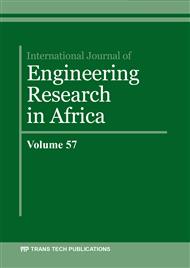[1]
T.R. Anderson, E. Hawkins, P.D. Jones, CO2, the greenhouse effect and global warming: from the pioneering work of Arrhenius and Callendar to today's Earth System Models, Endeavour. 40 (2016) 178–187. doi:https://doi.org/10.1016/j.endeavour.2016.07.002.
DOI: 10.1016/j.endeavour.2016.07.002
Google Scholar
[2]
F. Bernard, D.K. Papanastasiou, R.W. Portmann, V.C. Papadimitriou, J.B. Burkholder, Atmospheric lifetimes and global warming potentials of atmospherically persistent N(CxF2x+1)3, x = 2–4, perfluoroamines, Chem. Phys. Lett. 744 (2020) 137089. doi:https://doi.org/10.1016/j.cplett.2020.137089.
DOI: 10.1016/j.cplett.2020.137089
Google Scholar
[3]
IPCC, Climate Change 2007: The Physical Science Basis. Contribution of Working Group I to the Fourth Assessment Report of the Intergovernmental Panel on Climate Change, Cambridge University Press, Cambridge, United Kingdom and New York, NY, USA, (2007).
DOI: 10.1080/01944363.2014.954464
Google Scholar
[4]
A.D.A. Hansen, H. Rosen, T. Novakov, The aethalometer — An instrument for the real-time measurement of optical absorption by aerosol particles, Sci. Total Environ. 36 (1984) 191–196. doi:https://doi.org/10.1016/0048-9697(84)90265-1.
DOI: 10.1016/0048-9697(84)90265-1
Google Scholar
[5]
T.C. Bond, S.J. Doherty, D.W. Fahey, P.M. Forster, T. Berntsen, B.J. DeAngelo, M.G. Flanner, S. Ghan, B. Kärcher, D. Koch, S. Kinne, Y. Kondo, P.K. Quinn, M.C. Sarofim, M.G. Schultz, M. Schulz, C. Venkataraman, H. Zhang, S. Zhang, N. Bellouin, S.K. Guttikunda, P.K. Hopke, M.Z. Jacobson, J.W. Kaiser, Z. Klimont, U. Lohmann, J.P. Schwarz, D. Shindell, T. Storelvmo, S.G. Warren, C.S. Zender, Bounding the role of black carbon in the climate system: A scientific assessment, J. Geophys. Res. Atmos. 118 (2013) 5380–5552.
DOI: 10.1002/jgrd.50171
Google Scholar
[6]
S.C. Anenberg, J. Schwartz, D. Shindell, M. Amann, G. Faluvegi, Z. Klimont, G. Janssens-Maenhout, L. Pozzoli, R. Van Dingenen, E. Vignati, L. Emberson, N.Z. Muller, J.J. West, M. Williams, V. Demkine, W.K. Hicks, J. Kuylenstierna, F. Raes, V. Ramanathan, Global air quality and health co-benefits of mitigating near-term climate change through methane and black carbon emission controls, Environ. Health Perspect. 120 (2012) 831–839.
DOI: 10.1289/ehp.1104301
Google Scholar
[7]
H. Omidvarborna, A. Kumar, D.-S. Kim, Recent studies on soot modeling for diesel combustion, Renew. Sustain. Energy Rev. 48 (2015) 635–647. doi:https://doi.org/10.1016/j.rser.2015.04.019.
DOI: 10.1016/j.rser.2015.04.019
Google Scholar
[8]
C.M. Long, M.A. Nascarella, P.A. Valberg, Carbon black vs. black carbon and other airborne materials containing elemental carbon: Physical and chemical distinctions, Environ. Pollut. 181 (2013) 271–286. doi:https://doi.org/10.1016/j.envpol.2013.06.009.
DOI: 10.1016/j.envpol.2013.06.009
Google Scholar
[9]
E. Bastidas-Arteaga, M.G. Stewart, Damage risks and economic assessment of climate adaptation strategies for design of new concrete structures subject to chloride-induced corrosion, Struct. Saf. 52 (2015) 40–53. doi:https://doi.org/10.1016/j.strusafe.2014.10.005.
DOI: 10.1016/j.strusafe.2014.10.005
Google Scholar
[10]
A. V Saetta, B.A. Schrefler, R. V Vitaliani, The carbonation of concrete and the mechanism of moisture, heat and carbon dioxide flow through porous materials, Cem. Concr. Res. 23 (1993) 761–772. doi:https://doi.org/10.1016/0008-8846(93)90030-D.
DOI: 10.1016/0008-8846(93)90030-d
Google Scholar
[11]
M.G. Stewart, X. Wang, M.N. Nguyen, Climate change impact and risks of concrete infrastructure deterioration, Eng. Struct. 33 (2011) 1326–1337. doi:https://doi.org/10.1016/j.engstruct.2011.01.010.
DOI: 10.1016/j.engstruct.2011.01.010
Google Scholar
[12]
S.A. Mangi, M.H.W. Ibrahim, N. Jamaluddin, M.F. Arshad, R.P. Jaya, Short-term effects of sulphate and chloride on the concrete containing coal bottom ash as supplementary cementitious material, Eng. Sci. Technol. an Int. J. 22 (2019) 515–522. doi:https://doi.org/10.1016/j.jestch.2018.09.001.
DOI: 10.1016/j.jestch.2018.09.001
Google Scholar
[13]
L. Berredjem, N. Arabi, L. Molez, Mechanical and durability properties of concrete based on recycled coarse and fine aggregates produced from demolished concrete, Constr. Build. Mater. 246 (2020) 118421. doi:https://doi.org/10.1016/j.conbuildmat.2020.118421.
DOI: 10.1016/j.conbuildmat.2020.118421
Google Scholar
[14]
İ. Demir, S. Güzelkücük, Ö. Sevim, Effects of sulfate on cement mortar with hybrid pozzolan substitution, Eng. Sci. Technol. an Int. J. 21 (2018) 275–283. doi:https://doi.org/10.1016/j.jestch.2018.04.009.
DOI: 10.1016/j.jestch.2018.04.009
Google Scholar
[15]
D. Zhang, Q. Yang, M. Mao, J. Li, Carbonation performance of concrete with fly ash as fine aggregate after stress damage and high temperature exposure, Constr. Build. Mater. 242 (2020) 118125. doi:https://doi.org/10.1016/j.conbuildmat.2020.118125.
DOI: 10.1016/j.conbuildmat.2020.118125
Google Scholar
[16]
S.A. Mangi, M.H.W. Ibrahim, N. Jamaluddin, M.F. Arshad, S. Shahidan, Performances of concrete containing coal bottom ash with different fineness as a supplementary cementitious material exposed to seawater, Eng. Sci. Technol. an Int. J. 22 (2019) 929–938. doi:https://doi.org/10.1016/j.jestch.2019.01.011.
DOI: 10.1016/j.jestch.2019.01.011
Google Scholar
[17]
M. Otieno, J. Ikotun, Y. Ballim, Experimental investigations on the effect of concrete quality, exposure conditions and duration of initial moist curing on carbonation rate in concretes exposed to urban, inland environment, Constr. Build. Mater. 246 (2020) 118443. doi:https://doi.org/10.1016/j.conbuildmat.2020.118443.
DOI: 10.1016/j.conbuildmat.2020.118443
Google Scholar
[18]
X.-H. Wang, D. V Val, L. Zheng, M.R. Jones, Carbonation of loaded RC elements made of different concrete types: Accelerated testing and future predictions, Constr. Build. Mater. 243 (2020) 118259. doi:https://doi.org/10.1016/j.conbuildmat.2020.118259.
DOI: 10.1016/j.conbuildmat.2020.118259
Google Scholar
[19]
BS 8110-1, Structural use of concrete. Code of practice for design and construction, (1997)168.
Google Scholar
[20]
H. Hilsdorf, J. Kropp, Performance Criteria for Concrete Durability, CRC Press, (1995).
Google Scholar


